| Stylish Century | |
|---|---|
| Sire | Double Century (AUS) |
| Grandsire | Century (AUS) |
| Dam | Stylish (AUS) |
| Damsire | Forex (GB) |
| Sex | Stallion |
| Foaled | 1986 |
| Country | Australia |
| Colour | Brown |
| Owner | Mr R Mrs B & Miss K Monaghan |
| Trainer | N Doyle/ B Cummings /B Mitchell /R Gill /R Monaghan |
| Record | 58:11-8-7 |
| Earnings | A$2,510,250 |
| Major wins | |
| Spring Champion Stakes (1989) Victoria Derby (1989) Queen Elizabeth Stakes (1991) | |
Stylish Century was a notable Australian thoroughbred racehorse.
A son of Double Century from the Forex mare Stylish he was foaled in 1986 and was trained by a number of trainers throughout his career including Bart Cummings for a short time.
Known for his bold, front-running style he won quality races like the 1989 AJC Spring Champion Stakes, VRC Victoria Derby and the 1991 AJC Queen Elizabeth Stakes. As a 3-year old he also ran a close second to Almaarad in the 1989 MVRC W.S. Cox Plate.
He ran in the 1990 Japan Cup, won by David Hayes' Better Loosen Up. Stylish Century broke through the barrier and bolted prior to the race and was timed at a near world record pace for a 1000m before being vetted and declared fit to run.[ citation needed ] He ran a great race to lead them up well into the home straight and was by no means the last to cross the finish line.[ citation needed ]
Retired to stud, he only had moderate success with his best performer being Buster Jones winner of the 1999 VATC Sandown Stakes.
He died in 2003 following a spider bite.
58 starts - 11 wins, 8 seconds, 7 third
A$2,510,520
Stylish Century won the following major races:

Vain was a champion Thoroughbred racehorse that dominated Australian sprint racing in the period 1968–70, when he won 12 of the 14 races he contested and ran second in the other two. He went on to become a leading sire in Australia.
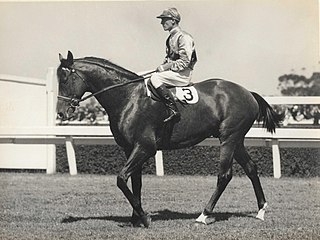
High Caste was a Thoroughbred racehorse and stallion that was bred in New Zealand and was considered the best two-year-old in New Zealand after winning three of his four race starts. He was a good racehorse under handicap and weight for age conditions and combined this with wins in good races from 5 furlongs to 1+3⁄4 miles (2,800 m), carrying up to 10 stone 6 pounds.

Poseidon was an Australian Thoroughbred Hall of Fame racehorse. He won 19 races over distances ranging from five furlongs to three miles. Sixteen of these wins were "Principal Races", eight of them now of Group 1 (G1) status.

Ajax was a champion Australian bred Thoroughbred racehorse and sire, who won 18 consecutive races before he was defeated at the odds of 40/1 on, causing a huge racing sensation. He had wins from 5 furlongs (1,000 m) to 1+1⁄2 miles (2,400 m), equalled the Australasian record for one mile (1,600 m), and created three new race records. At stud in Australia, Ajax proved to be a good sire. He was then sold as a 14-year-old horse and exported to the United States before he was later sold to Bing Crosby and Lin Howard. Ajax was inducted into the Australian Racing Hall of Fame in 2004.
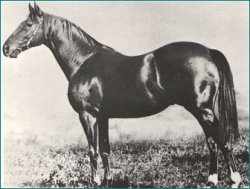
Heroic (1921–1939) was an Australian Thoroughbred racehorse who won 21 races from 5 furlongs to 2 miles (3,200m) and was a leading sire in Australia.
Leilani was a champion thoroughbred racemare that was bred in New Zealand and raced in Australia. She won six Group One races and a total of 12 black type equivalent races, during her short racing career. At the time of her retirement she held the Australasian earnings record for a mare.
Castletown was a New Zealand thoroughbred racehorse who won over $2 million in prize money and is best known for winning one of New Zealand's toughest staying tests, the Wellington Cup, on three occasions.
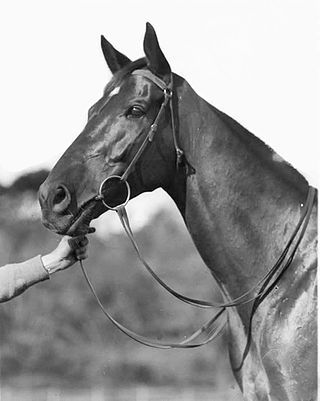
Amounis was an Australian Thoroughbred Hall of Fame racehorse. He won 33 races over distances ranging from 6 to 12 furlongs. Of these wins, 27 were in "Principal Races", 16 of these races have since been promoted to Group One (G1) status. In winning the AJC Epsom Handicap he established a new Australasian record time.
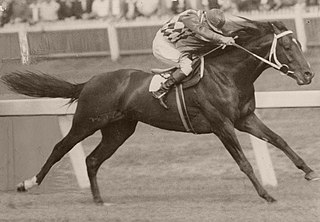
Comic Court (1945–1973) was a most versatile post-war Australian bred Thoroughbred racehorse who set race records at distances of 6 furlongs and 2 miles. He won the 1950 Melbourne Cup carrying 9 stone 5 pounds (59 kg) and set an Australasian record of 3 minutes 19½ seconds.
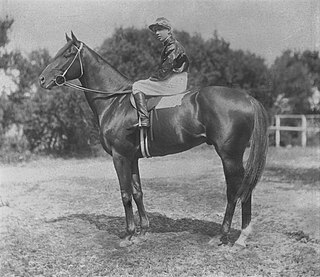
Eurythmic (1916–1925) was a versatile Australian-bred Thoroughbred racehorse who had the ability to produce a brilliant finishing run in staying races and he also won important sprint races, too. At four he won 12 of his 13 starts including the Caulfield Cup and Sydney Cup. When Eurythmic finished racing he was the greatest stake-winner in Australia. He was later inducted into the Australian Racing Hall of Fame.
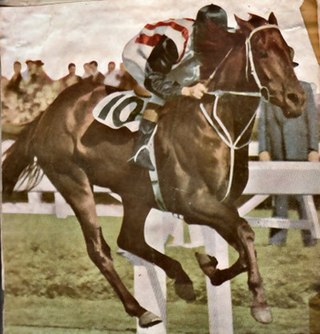
Tulloch was a champion Australian Thoroughbred racehorse who was one of the greatest Australian stayers.

Wenona Girl was a leading Australian Thoroughbred horse racemare that had 27 wins over distances ranging from 4½ furlongs to 1½ miles. She won 22 principal races, 15 of which were later designated group one (G1) races. Wenona Girl's principal wins included the VRC Sires Produce Stakes, AJC Sires Produce Stakes, George Adams Handicap, One Thousand Guineas, VATC Futurity Stakes, AJC George Main Stakes, AJC All Aged Stakes, AJC Adrian Knox Oaks Stakes, Rawson Stakes and Rosehill Guineas, all of which were later classified as G1 races. At the time of her retirement she was the highest stakes winning mare to have raced in Australia. At stud she was a good broodmare. Wenona Girl was later inducted into Australian Racing Hall of Fame.
Hydrogen was a champion Australian thoroughbred racehorse.
John Marshall was an Australian jockey from Perth, who was best known for riding Rogan Josh to victory in the 1999 Melbourne Cup.
Prince Foote (1906–1922) was an Australian Thoroughbred Stallion performing in Australia raced from a two-year-old to a five-year-old, recording 11 wins from 7 furlongs to 3 miles and trained by Australian Racing Hall of Fame inductee Frank McGrath senior.
Named by Clarke Anthony Shields, 'Double Century was a notable Australian Thoroughbred race horse.
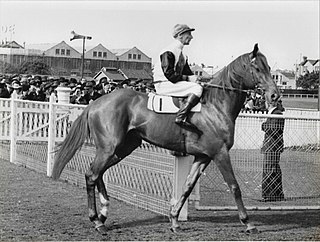
Yaralla was an Australian Thoroughbred racehorse who raced for 5 seasons from a two-year-old to a six-year-old recording major wins from 5 furlongs to 1¼ miles and regular Sydney jockey being Ted McMenamin.

Gothic was a black Australian thoroughbred stallion who raced for 4 seasons from a three-year-old to a six-year-old, recording major wins from 6 furlongs to 1½ miles and champion Sydney jockey Jim Pike the Australian Racing Hall of Fame inductee 2002 winning 9 races.
Beau Zam was a New Zealand-bred and Australian-trained Thoroughbred racehorse that won five Group 1 races.
McGinty, known in Australia as Mr McGinty, was a Group 1 winning New Zealand bred and trained race-horse and sire.